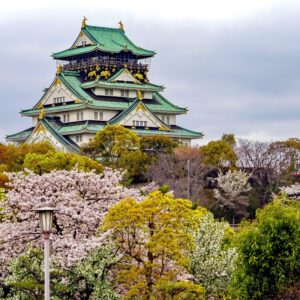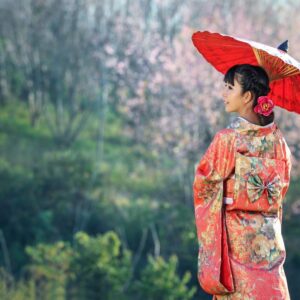Travel
A Destination Not to Be Missed in Japan
The Historical and Cultural Heart of Japan
One of the most iconic landmarks in Kyoto is the Kinkaku-ji (Golden Pavilion). This Zen Buddhist temple, covered in gold leaf, reflects beautifully in the surrounding pond, creating a picturesque scene that has been admired for centuries. Another must-visit is the Fushimi Inari Shrine, famous for its thousands of vermilion torii gates that form a path up the sacred Mount Inari. The journey through these gates is both visually stunning and spiritually uplifting.
Kyoto is also home to Nijo Castle, a UNESCO World Heritage Site that once served as the residence of Tokugawa shoguns. The castle is renowned for its “nightingale floors,” designed to chirp when walked upon, serving as a security measure against intruders. These historical sites are just a glimpse into Kyoto’s rich cultural heritage, making it a haven for history enthusiasts.

The Beauty of Kyoto’s Gardens and Nature
Kyoto is a city where nature and human creativity blend seamlessly, particularly in its gardens. The art of Japanese gardening has been perfected over centuries in Kyoto, with each garden offering a unique expression of tranquility and beauty.
The Ryoan-ji Temple is home to Japan’s most famous rock garden. This Zen garden, composed of carefully arranged rocks and white gravel, invites contemplation and introspection. Its minimalist design embodies the essence of Zen philosophy, where simplicity holds profound meaning.
For a more lush and vibrant experience, the Arashiyama Bamboo Grove is a must-see. Walking through the towering bamboo stalks, with sunlight filtering through the leaves, feels like entering another world. The serene atmosphere of the grove is complemented by the nearby Tenryu-ji Temple, a UNESCO World Heritage Site known for its stunning garden and peaceful ambiance.
During the cherry blossom season in spring, Kyoto transforms into a pink paradise. The Philosopher’s Path, a scenic walkway along a canal lined with cherry trees, becomes a popular spot for hanami (flower viewing). As the petals fall and blanket the ground, the city takes on an almost surreal beauty, making it a dream destination for photographers and nature lovers alike.
Kyoto’s Culinary Delights
No trip to Kyoto would be complete without indulging in its culinary offerings. Kyoto’s cuisine, known as Kyo-ryori, is characterized by its emphasis on seasonal ingredients, delicate flavors, and elegant presentation. It reflects the city’s deep connection with nature and its long-standing tradition of hospitality.
A highlight of Kyoto’s culinary scene is kaiseki, a multi-course meal that showcases the chef’s skill and creativity. Each dish is meticulously prepared and presented, often featuring local ingredients such as tofu, yuba (tofu skin), and fresh vegetables. Dining at a traditional kaiseki restaurant is not just a meal but an experience that engages all the senses.
For a taste of Kyoto’s street food, the Nishiki Market is the place to go. This bustling market, often referred to as “Kyoto’s Kitchen,” offers a wide variety of local delicacies. From skewered yakitori (grilled chicken) to fresh sashimi and sweet mochi, there’s something for every palate. Don’t forget to try yudofu (hot tofu), a simple yet delicious dish that has been a staple in Kyoto’s diet for centuries.
Tea lovers will find Kyoto to be a paradise, as the city is renowned for its tea culture. The Uji region, just south of Kyoto, is famous for producing some of the finest matcha (green tea) in Japan. Visiting a traditional tea house for a tea ceremony is a must-do experience, where you can savor the rich, earthy flavor of matcha while learning about the rituals and etiquette that have been passed down through generations.

Kyoto’s Crafts
Kyoto is also known for its traditional crafts, which have been perfected over centuries and continue to thrive today. These crafts are not only a testament to the city’s artistic heritage but also make for unique souvenirs that carry the spirit of Kyoto.
One of the most famous crafts is Kiyomizu-yaki (Kyoto pottery). This delicate and beautifully decorated pottery has been produced in the city since the 16th century. Visitors can explore the Kiyomizu-yaki Danchi area, where many pottery studios offer workshops, allowing you to try your hand at creating your own piece of Kyoto art.
Another traditional craft is Nishijin-ori, a type of silk weaving that dates back over 1,000 years. Nishijin-ori textiles are known for their intricate patterns and vibrant colors, often used in the creation of kimono and obi (sashes). The Nishijin Textile Center in Kyoto offers demonstrations of the weaving process and showcases stunning examples of this art form.
For those interested in more contemporary crafts, Kyoto is home to many artisans who blend traditional techniques with modern design. From handmade paper (washi) to lacquerware and bamboo crafts, the city offers a rich variety of artistic expressions that reflect its cultural depth.
Experiencing the Spiritual Side of Kyoto
Kyoto is often described as the spiritual heart of Japan, with its numerous temples, shrines, and sacred sites offering a place for reflection and peace. Whether you’re seeking spiritual enlightenment or simply a moment of tranquility, Kyoto’s spiritual heritage is sure to leave a lasting impression.
The Kiyomizu-dera Temple, perched on a hillside with a sweeping view of the city, is one of Kyoto’s most famous temples. The temple’s wooden stage, which juts out over the hillside, offers breathtaking views, especially during the cherry blossom and autumn foliage seasons. The temple is also known for its Otowa Waterfall, where visitors can drink from three streams, each believed to bring different blessings.
For a more intimate spiritual experience, the Daitoku-ji Temple Complex is a hidden gem. This Zen temple is less frequented by tourists, allowing for a more peaceful exploration of its beautiful gardens and meditation halls. The complex includes several sub-temples, each with its unique atmosphere and history.
Kyoto is also a center for traditional Japanese tea ceremonies, many of which are held in the serene settings of temples and gardens. Participating in a tea ceremony is a way to connect with the spiritual side of Kyoto, as the practice emphasizes mindfulness, simplicity, and appreciation of the present moment.
Kyoto’s Festivals and Seasonal Highlights
Kyoto’s cultural calendar is filled with festivals and events that celebrate the city’s traditions and seasonal changes. These festivals offer a unique opportunity to experience Kyoto’s cultural richness in a vibrant and festive atmosphere.
One of the most famous festivals is the Gion Matsuri, held every July. This month-long celebration dates back over a thousand years and features elaborate parades, traditional music, and street performances. The highlight of the festival is the Yamaboko Junko, a grand procession of beautifully decorated floats that wind through the streets of Kyoto.
In the autumn, the Jidai Matsuri (Festival of Ages) is another major event, where participants dress in historical costumes representing various periods of Kyoto’s history. The festival’s parade is a living history lesson, showcasing the city’s evolution from ancient times to the present day.
During the winter, the Arashiyama Hanatouro is a magical event where the bamboo grove and surrounding areas are illuminated with thousands of lanterns. The soft glow of the lights creates an ethereal atmosphere, highlighting the beauty of Kyoto’s landscapes even in the colder months.
Conclusion
Kyoto is a destination that offers something for everyone, whether you’re a history buff, nature lover, foodie, or spiritual seeker. Its rich cultural heritage, stunning natural beauty, and timeless traditions make it a place where the past and present coexist harmoniously. A visit to Kyoto is not just a trip; it’s an immersion into the soul of Japan, where every moment is an opportunity to discover something new and beautiful. If you’re planning a journey to Japan, Kyoto is truly a destination not to be missed.
Learn more: zgladnews travel

